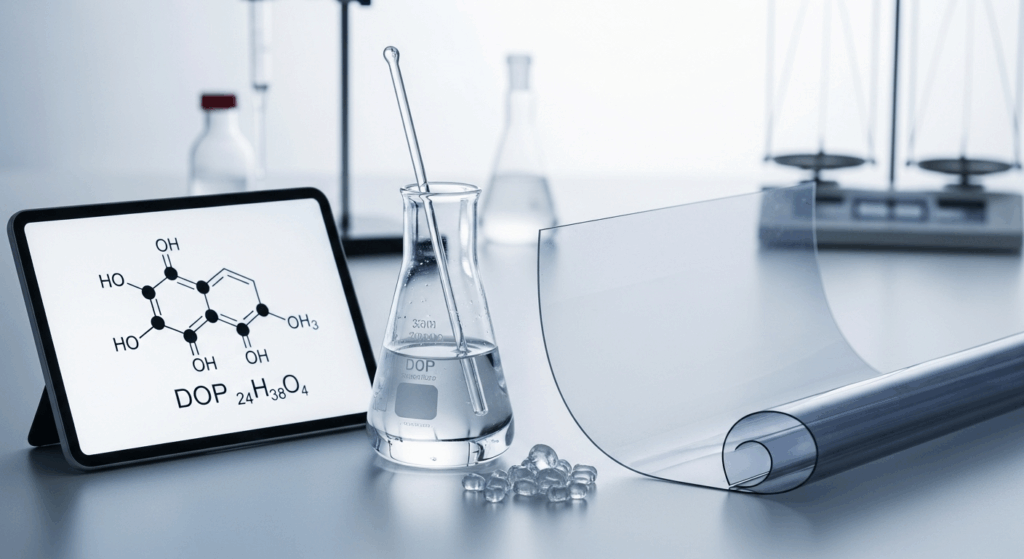DOP plasticizer makes plastics flexible and durable by reducing their stiffness and brittleness. Known chemically as dioctyl phthalate or bis(2-ethylhexyl) phthalate, this colorless oily liquid is the most widely used plasticizer in the world, found in everything from vinyl flooring to medical tubing.
Molecular Structure
The DOP plasticizer structure consists of a phthalate ester formed by combining phthalic acid with two molecules of 2-ethylhexyl alcohol. Picture it like a central benzene ring with two long, branching chains attached to it through ester bonds.
These branching chains are what make DOP so effective. Each chain contains eight carbon atoms arranged in a specific pattern – six carbons form the main backbone, with a two-carbon branch sticking out at the second position. This branching prevents the chains from packing too tightly together.
The molecular formula is C₂₄H₃₈O₄, giving it a molecular weight of 390.57 g/mol. This relatively large molecule slides between polymer chains like a lubricant, keeping them from sticking together and making the plastic flexible instead of rigid.

Physical Properties of DOP Plasticizer
| Property | Value | Significance |
|---|---|---|
| Appearance | Clear, colorless to pale yellow liquid | Easy visual quality check during production |
| Viscosity | 56-85 mPa·s at 20°C | Low enough for easy mixing but high enough to prevent migration |
| Density | 0.981-0.985 g/cm³ at 20°C | Slightly less dense than water, affects material calculations |
| Boiling Point | 385°C (725°F) | High boiling point prevents evaporation during processing |
| Melting Point | -50°C (-58°F) | Remains liquid even in cold conditions |
| Flash Point | 218°C (424°F) | Safe for most processing temperatures |
| Vapor Pressure | 1.2 × 10⁻⁷ mmHg at 20°C | Extremely low volatility reduces emissions |
| Refractive Index | 1.483-1.487 at 20°C | Used for quality control testing |
| Water Solubility | <0.01% at 20°C | Virtually insoluble, provides water resistance |
Chemical Properties of DOP Plasticizer
The chemical behavior of DOP determines its compatibility with different polymers and its long-term stability. These properties follow standard DOP plasticizer specification requirements used throughout the industry.
| Property | Value/Characteristic | Impact on Performance |
|---|---|---|
| Chemical Formula | C₂₄H₃₈O₄ | Defines molecular interactions |
| Ester Content | ≥99.5% | Higher purity means better performance |
| Acid Value | ≤0.07 mg KOH/g | Low acid prevents degradation |
| Hydroxyl Value | ≤0.5 mg KOH/g | Minimal free alcohol content |
| Saponification Value | 285-290 mg KOH/g | Indicates ester concentration |
| pH (aqueous extract) | 6-8 | Neutral, won’t corrode equipment |
| Thermal Stability | Stable up to 200°C | Suitable for high-temperature processing |
| Oxidation Resistance | Moderate | May need stabilizers for outdoor use |
| Hydrolysis Resistance | Good under normal conditions | Resists breakdown in humid environments |
| Compatibility | Excellent with PVC, good with other polymers | Primary use in vinyl products |